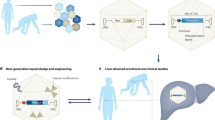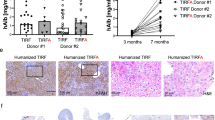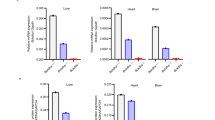Abstract
Adeno-associated virus (AAV) -mediated gene therapy is a promising strategy to treat liver-based monogenic diseases. However, two major obstacles limit its success: first, vector dilution in actively dividing cells, such as hepatocytes in neonates/children, due to the non-integrating nature of the vector; second, development of an immune response against the transgene and/or viral vector. Crigler–Najjar Syndrome Type I is a rare monogenic disease with neonatal onset, caused by mutations in the liver-specific UGT1 gene, with toxic accumulation of unconjugated bilirubin in plasma, tissues and brain. To establish an effective and long lasting cure, we applied AAV-mediated liver gene therapy to a relevant mouse model of the disease. Repeated gene transfer to adults by AAV-serotype switching, upon neonatal administration, resulted in lifelong correction of total bilirubin (TB) levels in both genders. In contrast, vector loss over time was observed after a single neonatal administration. Adult administration resulted in lifelong TB levels correction in male, but not female Ugt1−/− mice. Our findings demonstrate that neonatal AAV-mediated gene transfer to the liver supports a second transfer of the therapeutic vector, by preventing the induction of an immune response and supporting the possibility to improve AAV-therapeutic efficacy by repeated administration.
This is a preview of subscription content, access via your institution
Access options
Subscribe to this journal
Receive 12 print issues and online access
$259.00 per year
only $21.58 per issue
Buy this article
- Purchase on Springer Link
- Instant access to full article PDF
Prices may be subject to local taxes which are calculated during checkout






Similar content being viewed by others
References
Chen ZY, He CY, Meuse L, Kay MA . Silencing of episomal transgene expression by plasmid bacterial DNA elements in vivo. Gene Therapy 2004; 11: 856–864.
Chen ZY, Riu E, He CY, Xu H, Kay MA . Silencing of episomal transgene expression in liver by plasmid bacterial backbone DNA is independent of CpG methylation. Mol Ther 2008; 16: 548–556.
Giacca M, Zacchigna S . Virus-mediated gene delivery for human gene therapy. J Control Release 2012; 161: 377–388.
Nathwani AC, Tuddenham EG, Rangarajan S, Rosales C, McIntosh J, Linch DC et al. Adenovirus-associated virus vector-mediated gene transfer in hemophilia B. N Engl J Med 2011; 365: 2357–2365.
Nathwani AC, Reiss UM, Tuddenham EG, Rosales C, Chowdary P, McIntosh J et al. Long-term safety and efficacy of factor IX gene therapy in hemophilia B. N Engl J Med 2014; 371: 1994–2004.
Mingozzi F, High KA . Therapeutic in vivo gene transfer for genetic disease using AAV: progress and challenges. Nat Rev Genet 2011; 12: 341–355.
Wu Z, Asokan A, Samulski RJ . Adeno-associated virus serotypes: vector toolkit for human gene therapy. Mol Ther 2006; 14: 316–327.
Vance MA, Mitchell A, Samulski RJ . AAV Biology, Infectivity and Therapeutic Use from Bench to Clinic. In: Hashad D (ed). Gene Therapy - Principles and Challenges. InTech, (2015); doi:10.5772/59824.
Chadderton N, Millington-Ward S, Palfi A, O'Reilly M, Tuohy G, Humphries MM et al. Improved retinal function in a mouse model of dominant retinitis pigmentosa following AAV-delivered gene therapy. Mol Ther 2009; 17: 593–599.
Maguire AM, High KA, Auricchio A, Wright JF, Pierce EA, Testa F et al. Age-dependent effects of RPE65 gene therapy for Leber's congenital amaurosis: a phase 1 dose-escalation trial. Lancet 2009; 374: 1597–1605.
Mendell JR, Campbell K, Rodino-Klapac L, Sahenk Z, Shilling C, Lewis S et al. Dystrophin immunity in Duchenne's muscular dystrophy. N Engl J Med 2010; 363: 1429–1437.
Mendell JR, Sahenk Z, Malik V, Gomez AM, Flanigan KM, Lowes LP et al. A phase 1/2a Follistatin gene therapy trial for Becker muscular dystrophy. Mol Ther 2015; 23: 192–201.
MacLaren RE, Groppe M, Barnard AR, Cottriall CL, Tolmachova T, Seymour L et al. Retinal gene therapy in patients with choroideremia: initial findings from a phase 1/2 clinical trial. Lancet 2014; 383: 1129–1137.
Cunningham SC, Dane AP, Spinoulas A, Logan GJ, Alexander IE . Gene delivery to the juvenile mouse liver using AAV2/8 vectors. Mol Ther 2008; 16: 1081–1088.
Chandler RJ, LaFave MC, Varshney GK, Trivedi NS, Carrillo-Carrasco N, Senac JS et al. Vector design influences hepatic genotoxicity after adeno-associated virus gene therapy. J Clin Invest 2015; 125: 870–880.
Donsante A, Vogler C, Muzyczka N, Crawford JM, Barker J, Flotte T et al. Observed incidence of tumorigenesis in long-term rodent studies of rAAV vectors. Gene Therapy 2001; 8: 1343–1346.
Manno CS, Pierce GF, Arruda VR, Glader B, Ragni M, Rasko JJ et al. Successful transduction of liver in hemophilia by AAV-factor IX and limitations imposed by the host immune response. Nat Med 2006; 12: 342–347.
Moss RB, Rodman D, Spencer LT, Aitken ML, Zeitlin PL, Waltz D et al. Repeated adeno-associated virus serotype 2 aerosol-mediated cystic fibrosis transmembrane regulator gene transfer to the lungs of patients with cystic fibrosis: a multicenter, double-blind, placebo-controlled trial. Chest 2004; 125: 509–521.
Mueller C, Flotte TR . Clinical gene therapy using recombinant adeno-associated virus vectors. Gene Therapy 2008; 15: 858–863.
Weinstein DA, Correia CE, Conlon T, Specht A, Verstegen J, Onclin-Verstegen K et al. Adeno-associated virus-mediated correction of a canine model of glycogen storage disease type Ia. Hum Gene Ther 2010; 21: 903–910.
Wang L, Calcedo R, Nichols TC, Bellinger DA, Dillow A, Verma IM et al. Sustained correction of disease in naive and AAV2-pretreated hemophilia B dogs: AAV2/8-mediated, liver-directed gene therapy. Blood 2005; 105: 3079–3086.
Vandenberghe LH, Wilson JM, Gao G . Tailoring the AAV vector capsid for gene therapy. Gene Therapy 2009; 16: 311–319.
Mingozzi F, High KA . Immune responses to AAV vectors: overcoming barriers to successful gene therapy. Blood 2013; 122: 23–36.
Goudy KS, Annoni A, Naldini L, Roncarolo MG . Manipulating immune tolerance with Micro-RNA regulated gene therapy. Front Microbiol 2011; 2: 221.
McKay TR, Rahim AA, Buckley SM, Ward NJ, Chan JK, Howe SJ et al. Perinatal gene transfer to the liver. Curr Pharmaceut Des 2011; 17: 2528–2541.
Binny C, McIntosh J, Della Peruta M, Kymalainen H, Tuddenham EG, Buckley SM et al. AAV-mediated gene transfer in the perinatal period results in expression of FVII at levels that protect against fatal spontaneous hemorrhage. Blood 2012; 119: 957–966.
Flageul M, Aubert D, Pichard V, Nguyen TH, Nowrouzi A, Schmidt M et al. Transient expression of genes delivered to newborn rat liver using recombinant adeno-associated virus 2/8 vectors. J Gene Med 2009; 11: 689–696.
Wang L, Wang H, Bell P, McMenamin D, Wilson JM . Hepatic gene transfer in neonatal mice by adeno-associated virus serotype 8 vector. Hum Gene Ther 2012; 23: 533–539.
Miranda PS, Bosma PJ . Towards liver-directed gene therapy for Crigler-Najjar syndrome. Curr Gene Ther 2009; 9: 72–82.
Seppen J, van Til NP, van der Rijt R, Hiralall JK, Kunne C, Elferink RP . Immune response to lentiviral bilirubin UDP-glucuronosyltransferase gene transfer in fetal and neonatal rats. Gene Therapy 2006; 13: 672–677.
Bortolussi G, Zentilin L, Baj G, Giraudi P, Bellarosa C, Giacca M et al. Rescue of bilirubin-induced neonatal lethality in a mouse model of Crigler-Najjar syndrome type I by AAV9-mediated gene transfer. FASEB J 2012; 26: 1052–1063.
Bortolussi G, Zentilin L, Vanikova J, Bockor L, Bellarosa C, Mancarella A et al. Life-long correction of hyperbilirubinemia with a neonatal liver-specific AAV-mediated gene transfer in a lethal mouse model of Crigler Najjar Syndrome. Hum Gene Ther 2014; 25: 844–855.
Bosma PJ . Inherited disorders of bilirubin metabolism. J Hepatol 2003; 38: 107–117.
Crigler JF Jr, Najjar VA . Congenital familial nonhemolytic jaundice with kernicterus. Pediatrics 1952; 10: 169–180.
Erlinger S, Arias IM, Dhumeaux D . Inherited disorders of bilirubin transport and conjugation: new insights into molecular mechanisms and consequences. Gastroenterology 2014; 146: 1625–1638.
Adam R, Karam V, Delvart V, O'Grady J, Mirza D, Klempnauer J et al. Evolution of indications and results of liver transplantation in Europe. A report from the European Liver Transplant Registry (ELTR). J Hepatol 2012; 57: 675–688.
Fagiuoli S, Daina E, D'Antiga L, Colledan M, Remuzzi G . Monogenic diseases that can be cured by liver transplantation. J Hepatol 2013; 59: 595–612.
Annoni A, Brown BD, Cantore A, Sergi LS, Naldini L, Roncarolo MG . In vivo delivery of a microRNA-regulated transgene induces antigen-specific regulatory T cells and promotes immunologic tolerance. Blood 2009; 114: 5152–5161.
Schmitt F, Remy S, Dariel A, Flageul M, Pichard V, Boni S et al. Lentiviral vectors that express UGT1A1 in liver and contain miR-142 target sequences normalize hyperbilirubinemia in Gunn rats. Gastroenterology 2010; 139: 999–1007; 1007 e1-2.
Seppen J, Bakker C, de Jong B, Kunne C, van den Oever K, Vandenberghe K et al. Adeno-associated virus vector serotypes mediate sustained correction of bilirubin UDP glucuronosyltransferase deficiency in rats. Mol Ther 2006; 13: 1085–1092.
Pastore N, Nusco E, Vanikova J, Sepe RM, Vetrini F, McDonagh A et al. Sustained reduction of hyperbilirubinemia in Gunn rats after adeno-associated virus-mediated gene transfer of bilirubin UDP-glucuronosyltransferase isozyme 1A1 to skeletal muscle. Hum Gene Ther 2012; 23: 1082–1089.
Wang L, Takabe K, Bidlingmaier SM, Ill CR, Verma IM . Sustained correction of bleeding disorder in hemophilia B mice by gene therapy. Proc Natl Acad Sci USA 1999; 96: 3906–3910.
Xu L, Daly T, Gao C, Flotte TR, Song S, Byrne BJ et al. CMV-beta-actin promoter directs higher expression from an adeno-associated viral vector in the liver than the cytomegalovirus or elongation factor 1 alpha promoter and results in therapeutic levels of human factor X in mice. Hum Gene Ther 2001; 12: 563–573.
Cunningham SC, Spinoulas A, Carpenter KH, Wilcken B, Kuchel PW, Alexander IE . AAV2/8-mediated correction of OTC deficiency is robust in adult but not neonatal Spf(ash) mice. Mol Ther 2009; 17: 1340–1346.
Mingozzi F, Liu YL, Dobrzynski E, Kaufhold A, Liu JH, Wang Y et al. Induction of immune tolerance to coagulation factor IX antigen by in vivo hepatic gene transfer. J Clin Invest 2003; 111: 1347–1356.
Kramer MG, Barajas M, Razquin N, Berraondo P, Rodrigo M, Wu C et al. In vitro and in vivo comparative study of chimeric liver-specific promoters. Mol Ther 2003; 7: 375–385.
Chuah MK, Petrus I, De Bleser P, Le Guiner C, Gernoux G, Adjali O et al. Liver-specific transcriptional modules identified by genome-wide in silico analysis enable efficient gene therapy in mice and non-human primates. Mol Ther 2014; 22: 1605–1613.
Ronzitti G, Bortolussi G, van Dijk R, Collaud F, Charles S, Leborgne C et al. A translationally optimized AAV-UGT1A1 vector drives safe and long-lasting correction of Crigler-Najjar syndrome. Mol Ther Methods Clin Dev 2016; 3: 16049.
Ponder KP . Immunology of neonatal gene transfer. Curr Gene Ther 2007; 7: 403–410.
Sabatino DE, Mackenzie TC, Peranteau W, Edmonson S, Campagnoli C, Liu YL et al. Persistent expression of hF.IX After tolerance induction by in utero or neonatal administration of AAV-1- F.IX in hemophilia B mice. Mol Ther 2007; 15: 1677–1685.
Waddington SN, Buckley SM, Nivsarkar M, Jezzard S, Schneider H, Dahse T et al. In utero gene transfer of human factor IX to fetal mice can induce postnatal tolerance of the exogenous clotting factor. Blood 2003; 101: 1359–1366.
Mingozzi F, Anguela XM, Pavani G, Chen Y, Davidson RJ, Hui DJ et al. Overcoming preexisting humoral immunity to AAV using capsid decoys. Sci Transl Med 2013; 5: 194ra92.
Chicoine LG, Montgomery CL, Bremer WG, Shontz KM, Griffin DA, Heller KN et al. Plasmapheresis eliminates the negative impact of AAV antibodies on microdystrophin gene expression following vascular delivery. Mol Ther 2014; 22: 338–347.
Takahashi M, Ilan Y, Chowdhury NR, Guida J, Horwitz M, Chowdhury JR . Long term correction of bilirubin-UDP-glucuronosyltransferase deficiency in Gunn rats by administration of a recombinant adenovirus during the neonatal period. J Biol Chem 1996; 271: 26536–26542.
Mahler JF, Stokes W, Mann PC, Takaoka M, Maronpot RR . Spontaneous lesions in aging FVB/N mice. Toxicol Pathol 1996; 24: 710–716.
Davidoff AM, Ng CY, Zhou J, Spence Y, Nathwani AC . Sex significantly influences transduction of murine liver by recombinant adeno-associated viral vectors through an androgen-dependent pathway. Blood 2003; 102: 480–488.
Berraondo P, Crettaz J, Ochoa L, Paneda A, Prieto J, Troconiz IF et al. Intrahepatic injection of recombinant adeno-associated virus serotype 2 overcomes gender-related differences in liver transduction. Hum Gene Ther 2006; 17: 601–610.
Nathwani AC, Gray JT, McIntosh J, Ng CY, Zhou J, Spence Y et al. Safe and efficient transduction of the liver after peripheral vein infusion of self-complementary AAV vector results in stable therapeutic expression of human FIX in nonhuman primates. Blood 2007; 109: 1414–1421.
Voutetakis A, Zheng C, Wang J, Goldsmith CM, Afione S, Chiorini JA et al. Gender differences in serotype 2 adeno-associated virus biodistribution after administration to rodent salivary glands. Hum Gene Ther 2007; 18: 1109–1118.
Tarantal AF, Lee CC . Long-term luciferase expression monitored by bioluminescence imaging after adeno-associated virus-mediated fetal gene delivery in rhesus monkeys (Macaca mulatta). Hum Gene Ther 2010; 21: 143–148.
D'Avola D, Lopez-Franco E, Sangro B, Paneda A, Grossios N, Gil-Farina I et al. Phase I open label liver-directed gene therapy clinical trial for acute intermittent porphyria. J Hepatol 2016; 65: 776–783.
Boisgerault F, Gross DA, Ferrand M, Poupiot J, Darocha S, Richard I et al. Prolonged gene expression in muscle is achieved without active immune tolerance using microrRNA 142.3p-regulated rAAV gene transfer. Hum Gene Ther 2013; 24: 393–405.
Brown BD, Cantore A, Annoni A, Sergi LS, Lombardo A, Della Valle P et al. A microRNA-regulated lentiviral vector mediates stable correction of hemophilia B mice. Blood 2007; 110: 4144–4152.
Jooss K, Yang Y, Fisher KJ, Wilson JM . Transduction of dendritic cells by DNA viral vectors directs the immune response to transgene products in muscle fibers. J Virol 1998; 72: 4212–4223.
LoDuca PA, Hoffman BE, Herzog RW . Hepatic gene transfer as a means of tolerance induction to transgene products. Curr Gene Ther 2009; 9: 104–114.
Margolin KA, Negrin RS, Wong KK, Chatterjee S, Wright C, Forman SJ . Cellular immunotherapy and autologous transplantation for hematologic malignancy. Immunol Rev 1997; 157: 231–240.
Lu Y, Song S . Distinct immune responses to transgene products from rAAV1 and rAAV8 vectors. Proc Natl Acad Sci USA 2009; 106: 17158–17162.
Qiao C, Yuan Z, Li J, He B, Zheng H, Mayer C et al. Liver-specific microRNA-122 target sequences incorporated in AAV vectors efficiently inhibits transgene expression in the liver. Gene Therapy 2011; 18: 403–410.
Cotugno G, Annunziata P, Barone MV, Karali M, Banfi S, Auricchio A . Impact of age at administration, lysosomal storage, and transgene regulatory elements on AAV2/8-mediated rat liver transduction. PloS one 2012; 7: e33286.
Arsic N, Zacchigna S, Zentilin L, Ramirez-Correa G, Pattarini L, Salvi A et al. Vascular endothelial growth factor stimulates skeletal muscle regeneration in vivo. Mol Ther 2004; 10: 844–854.
Inagaki K, Fuess S, Storm TA, Gibson GA, McTiernan CF, Kay MA et al. Robust systemic transduction with AAV9 vectors in mice: efficient global cardiac gene transfer superior to that of AAV8. Mol Ther 2006; 14: 45–53.
Nakai H, Fuess S, Storm TA, Muramatsu S, Nara Y, Kay MA . Unrestricted hepatocyte transduction with adeno-associated virus serotype 8 vectors in mice. J Virol 2005; 79: 214–224.
Bortolussi G, Codarin E, Antoniali G, Vascotto C, Vodret S, Arena S et al. Impairment of enzymatic antioxidant defenses is associated with bilirubin-induced neuronal cell death in the cerebellum of Ugt1 KO mice. Cell Death Dis 2015; 6: e1739.
Acknowledgements
We thank Prof E Tongiorgi from University of Trieste, Italy for the microscope facility resources; the ICGEB bioExperimentation Facility for help with animal care; to Dr M Bestagno for help with the FACS; M Dapas and M Zotti for AAV production; B Boziglav for the help in histological preparations; Dr Gloria Gonzalez Aseguinolaza from CIMA, Spain who kindly provided the authors with the construct containing Albumin promoter and Albumin enhancer element-AAT promoter. This work was supported by Telethon (GGP10051) and by Beneficentia Stiftung to AFM (ICGEB).
Author information
Authors and Affiliations
Corresponding author
Ethics declarations
Competing interests
The authors declare no conflict of interest.
Additional information
Supplementary Information accompanies this paper on Gene Therapy website
Supplementary information
Rights and permissions
About this article
Cite this article
Bočkor, L., Bortolussi, G., Iaconcig, A. et al. Repeated AAV-mediated gene transfer by serotype switching enables long-lasting therapeutic levels of hUgt1a1 enzyme in a mouse model of Crigler–Najjar Syndrome Type I. Gene Ther 24, 649–660 (2017). https://doi.org/10.1038/gt.2017.75
Received:
Revised:
Accepted:
Published:
Issue Date:
DOI: https://doi.org/10.1038/gt.2017.75
This article is cited by
-
Immune profiling of adeno-associated virus response identifies B cell-specific targets that enable vector re-administration in mice
Gene Therapy (2023)
-
Functional gene delivery to and across brain vasculature of systemic AAVs with endothelial-specific tropism in rodents and broad tropism in primates
Nature Communications (2023)
-
Delivery of cancer therapies by synthetic and bio-inspired nanovectors
Molecular Cancer (2021)
-
Experimental models assessing bilirubin neurotoxicity
Pediatric Research (2020)
-
Human liver stem cells express UGT1A1 and improve phenotype of immunocompromised Crigler Najjar syndrome type I mice
Scientific Reports (2020)



